In Vitro Antioxidant and Anti-Propionibacterium acnes Activities of Cold Water, Hot Water, and Methanol Extracts, and Their Respective Ethyl Acetate Fractions, from Sanguisorba officinalis L. Roots
Abstract
1. Introduction
2. Results
2.1. Total Phenolic, Flavonoid, Terpenoid, and Condensed Tannin Contents in the CWE, HWE, ME, and their Respective EA Fractions
2.2. Antibacterial Activities of the CWE, HWE, ME, and their Respective EA Fractions
2.3. In Vitro Antioxidant Activity of the CWE, HWE, ME, and their Respective EA Fractions
2.4. HPLC-UV and UHPLC-QTOF-MS Analyses
3. Discussion
4. Materials and Methods
4.1. Plant Material
4.2. Preparation of Cold Water, Hot Water, and Methanol Extracts, and their Respective Fractions
4.3. Analysis of the CWE, HWE, ME, and their Respective EA Fractions
4.3.1. Determination of Total Phenolic Content
4.3.2. Determination of Total Flavonoid Content
4.3.3. Determination of Total Terpenoid Content
4.3.4. Determination of Condensed Tannin Content
4.4. Microorganisms and Culture
4.5. Determination of Antibacterial Activity
4.5.1. Paper Disc Diffusion Method
4.5.2. MIC and MBC
4.6. In Vitro Antioxidant Activities of the CWE, HWE, ME, and their Respective EA Fractions
4.6.1. DPPH Assay
4.6.2. Total Antioxidant Assay
4.6.3. Hydroxide Peroxide Scavenging Assay
4.6.4. Linoleic Acid Peroxidation Inhibition Assay
4.7. HPLC Analysis
4.8. UHPLC-QTOF-MS
4.9. Statistical Analysis
5. Conclusions
Supplementary Materials
Author Contributions
Funding
Acknowledgments
Conflicts of Interest
References
- Aydemir, E.H. Acne vulgaris. Turk. Pediatr. Ars. 2014, 49, 13–16. [Google Scholar] [CrossRef] [PubMed]
- Graham, G.M.; Farrar, M.D.; Cruse-Sawyer, J.E.; Holland, K.T.; Ingham, E. Proinflammatory cytokine production by human keratinocytes stimulated with Propionibacterium acnes and P. acnes GroEL. Br. J. Dermatol. 2004, 150, 421–428. [Google Scholar] [CrossRef] [PubMed]
- Tan, A.U.; Schlosser, B.J.; Paller, A.S. A review of diagnosis and treatment of acne in adult female patients. Int. J. Womens Dermatol. 2018, 4, 56–71. [Google Scholar] [CrossRef] [PubMed]
- Zaenglein, A.L.; Pathy, A.L.; Schlosser, B.J.; Alikhan, A.; Baldwin, H.E.; Berson, D.S.; Bowe, W.P.; Graber, E.M.; Harper, J.C.; Kang, S.; et al. Guidelines of care for the management of acne vulgaris. J. Am. Acad. Dermatol. 2016, 74, 945–973. [Google Scholar] [CrossRef] [PubMed]
- Alexis, A.F. Clinical considerations on the use of concomitant therapy in the treatment of acne. J. Dermatol. Treat. 2008, 19, 199–209. [Google Scholar] [CrossRef] [PubMed]
- Elston, D.M. Topical antibiotics in dermatology: Emerging patterns of resistance. Dermatol. Clin. 2009, 27, 25–31. [Google Scholar] [CrossRef] [PubMed]
- Humphrey, S. Antibiotic resistance in acne treatment. Skin Therapy Lett. 2012, 17, 1–3. [Google Scholar] [PubMed]
- Kanlayavattanakul, M.; Lourith, N. Therapeutic agents and herbs in topical application for acne treatment. Int. J. Cosmet. Sci. 2011, 33, 289–297. [Google Scholar] [CrossRef] [PubMed]
- Karkanis, A.; Vellios, E.; Thomaidis, T.; Bilalis, D.; Efthimiadou, A.; Travlos, I. Phytochemistry and biological properties of burnet weed (Sanguisorba spp.): A review. Not. Sci. Biol. 2014, 6, 395–398. [Google Scholar] [CrossRef]
- Nguyen, T.T.; Cho, S.O.; Ban, J.Y.; Kim, J.Y.; Ju, H.S.; Koh, S.B.; Song, K.-S.; Seong, Y.H. Neuroprotective effect of Sanguisorbae radix against oxidative stress-induced brain damage: In vitro and in vivo. Biol. Pharm. Bull. 2008, 31, 2028–2035. [Google Scholar] [CrossRef] [PubMed]
- Zhang, L.; Koyyalamudi, S.R.; Jeong, S.C.; Reddy, N.; Smith, P.T.; Ananthan, R.; Longvah, T. Antioxidant and immunomodulatory activities of polysaccharides from the roots of Sanguisorba officinalis. Int. J. Biol. Macromol. 2012, 51, 1057–1062. [Google Scholar] [CrossRef] [PubMed]
- Cai, Z.; Li, W.; Wang, H.; Yan, W.; Zhou, Y.; Wang, G.; Cui, J.; Wang, F. Anti-tumor and immunomodulating activities of a polysaccharide from the root of Sanguisorba officinalis L. Int. J. Biol. Macromol. 2012, 51, 484–488. [Google Scholar] [CrossRef] [PubMed]
- Wang, Z.; Loo, W.T.; Wang, N.; Chow, L.W.C.; Wang, D.; Han, F.; Zheng, X.; Chen, J.-P. Effect of Sanguisorba officinalis L on breast cancer growth and angiogenesis. Expert Opin. Ther. Targets 2012, 16, S79–S89. [Google Scholar] [CrossRef] [PubMed]
- Shin, J.A.; Kim, J.S.; Kwon, K.H.; Nam, J.S.; Jung, J.Y.; Cho, N.P.; Cho, S.D. Apoptotic effect of hot water extract of Sanguisorba officinalis L. in human oral cancer cells. Oncol. Lett. 2012, 4, 489–494. [Google Scholar] [CrossRef] [PubMed]
- Choi, E.S.; Kim, J.S.; Kwon, K.H.; Kim, H.S.; Cho, N.P.; Cho, S.D. Methanol extract of Sanguisorba officinalis L. with cytotoxic activity against PC3 human prostate cancer cells. Mol. Med. Rep. 2012, 6, 670–674. [Google Scholar] [CrossRef] [PubMed]
- Liu, M.-P.; Liao, M.; Dai, C.; Chen, J.-F.; Yang, C.-J.; Liu, M.; Chen, Z.-G.; Yao, M.-C. Sanguisorba officinalis L. synergistically enhanced 5-fluorouracil cytotoxicity in colorectal cancer cells by promoting a reactive oxygen species-mediated, mitochondria-caspase-dependent apoptotic pathway. Sci. Rep. 2016, 6, 34245. [Google Scholar] [CrossRef] [PubMed]
- Yu, T.; Lee, Y.J.; Yang, H.M.; Han, S.; Kim, J.H.; Lee, Y.; Kim, C.; Han, M.H.; Kim, M.-Y.; Lee, J.; et al. Inhibitory effect of Sanguisorba officinalis ethanol extract on NO and PGE₂ production is mediated by suppression of NF-κB and AP-1 activation signaling cascade. J. Ethnopharmacol. 2011, 134, 11–17. [Google Scholar] [CrossRef] [PubMed]
- Yang, J.H.; Hwang, Y.H.; Gu, M.J.; Cho, W.K.; Ma, J.Y. Ethanol extracts of Sanguisorba officinalis L. suppress TNF-α/IFN-γ-induced pro-inflammatory chemokine production in HaCaT cells. Phytomedicine 2015, 22, 1262–1268. [Google Scholar] [CrossRef] [PubMed]
- Menković, N.; Zdunić, G.; Šavikin, K.; Stanojković, T.; Juranić, Z.; Janković, T. Preliminary investigation of cytotoxic and antioxidant activity of some medicinal plants growing in Serbia and Montenegro. Planta Med. 2007, 73, 043. [Google Scholar] [CrossRef]
- Zhang, S.; Liu, X.; Zhang, Z.L.; He, L.; Wang, Z.; Wang, G.S. Isolation and identification of the phenolic compounds from the roots of Sanguisorba officinalis L. and their antioxidant activities. Molecules 2012, 17, 13917–13922. [Google Scholar] [CrossRef] [PubMed]
- Seo, C.-S.; Jeong, S.-J.; Yoo, S.-R.; Lee, N.-R.; Shin, H.-K. Quantitative analysis and in vitro anti-inflammatory effects of gallic acid, ellagic acid, and quercetin from Radix Sanguisorbae. Pharmacogn. Mag. 2016, 12, 104–108. [Google Scholar] [PubMed]
- Kim, T.G.; Kang, S.Y.; Jung, K.K.; Kang, J.H.; Lee, E.; Han, H.M.; Kim, S.H. Antiviral activities of extracts isolated from Terminalis chebula retz., Sanguisorba officinalis L., Rubus coreanus miq. and Rheum palmatum L. against hepatitis B virus. Phytother. Res. 2001, 15, 718–720. [Google Scholar] [CrossRef] [PubMed]
- Liang, J.; Chen, J.; Tan, Z.; Peng, J.; Zheng, X.; Nishiura, K.; Ng, J.; Wang, Z.; Wang, D.; Chen, Z.; et al. Extracts of medicinal herb Sanguisorba officinalis inhibit the entry of human immunodeficiency virus type one. J. Food Drug Anal. 2013, 21, S52–S58. [Google Scholar] [CrossRef] [PubMed]
- Kim, Y.H.; Chung, C.B.; Kim, J.G.; Ko, K.I.; Park, S.H.; Kim, J.-H.; Eom, S.Y.; Kim, Y.S.; Hwang, Y.-I.; Kim, K.H. Anti-wrinkle activity of ziyuglycoside I isolated from a Sanguisorba officinalis root extract and its application as a cosmeceutical ingredient. Biosci. Biotechnol. Biochem. 2008, 72, 303–311. [Google Scholar] [CrossRef] [PubMed]
- Mimaki, Y.; Fukushima, M.; Yokosuka, A.; Sashida, Y.; Furuya, S.; Sakagami, H. Triterpene glycosides from the roots of Sanguisorba officinalis. Phytochemistry 2001, 57, 773–779. [Google Scholar] [CrossRef]
- Liu, X.; Cui, Y.; Yu, Q.; Yu, B. Triterpenoids from Sanguisorba officinalis. Phytochemistry 2005, 66, 1671–1679. [Google Scholar] [CrossRef] [PubMed]
- Sun, W.; Zhang, Z.L.; Liu, X.; Zhang, S.; He, L.; Wang, Z.; Wang, G.-S. Terpene glycosides from the roots of Sanguisorba officinalis L. and their hemostatic activities. Molecules 2012, 17, 7629–7636. [Google Scholar] [CrossRef] [PubMed]
- Hu, J.; Song, Y.; Li, H.; Yang, B.; Mao, X.; Zhao, Y.; Shi, X. Cytotoxic triterpene glycosides from the roots of Sanguisorba officinalis. Arch. Pharm. Res. 2015, 38, 984–990. [Google Scholar] [CrossRef] [PubMed]
- Xie, Y.; Yang, W.; Tang, F.; Chen, X.; Ren, L. Antibacterial activities of flavonoids: Structure–activity relationship and mechanism. Curr. Med. Chem. 2015, 22, 132–149. [Google Scholar] [CrossRef] [PubMed]
- Kim, S.H.; Kim, D.K.; Eom, D.O.; Kim, S.Y.; Kim, S.H.; Shin, T.Y. Sanguisorba officinalis inhibits immediate-type allergic reactions. Nat. Prod. Sci. 2002, 8, 177–182. [Google Scholar]
- Shan, B.; Cai, Y.Z.; Brooks, J.D.; Corke, H. The in vitro antibacterial activity of dietary spice and medicinal herb extracts. Int. J. Food Microbiol. 2007, 117, 112–119. [Google Scholar] [CrossRef] [PubMed]
- Gawron-Gzella, A.; Witkowska-Banaszczak, E.; Bylka, W.; Dudek-Makuch, M.; Odwrot, A.; Skrodzka, N. Chemical composition, antioxidant and antimicrobial activities of Sanguisorba officinalis L. extracts. Pharm. Chem. J. 2016, 50, 244–249. [Google Scholar] [CrossRef]
- Ginovyan, M.; Petrosyan, M.; Trchounian, A. Antimicrobial activity of some plant materials used in Armenian traditional medicine. BMC Complement. Altern. Med. 2017, 17, 50. [Google Scholar] [CrossRef] [PubMed]
- Shin, S.W.; Ghimeray, A.K.; Park, C.H. Investigation of total phenolic, total flavonoid, antioxidant and allyl isothiocyanate content in the different organs of Wasabi japonica grown in an organic system. Afr. J. Tradit. Complement. Altern. Med. 2014, 11, 38–45. [Google Scholar] [CrossRef] [PubMed]
- Gálvez, M.; Martín-Cordero, C.; Houghton, P.J.; Ayuso, M.J. Antioxidant activity of methanol extracts obtained from Plantago species. J. Agric. Food Chem. 2005, 53, 1927–1933. [Google Scholar] [CrossRef] [PubMed]
- Kokoska, L.; Polesny, Z.; Rada, V.; Nepovim, A.; Vanek, T. Screening of some Siberian medicinal plants for antimicrobial activity. J. Ethnopharmacol. 2002, 82, 51–53. [Google Scholar] [CrossRef]
- Lee, H.A.; Hong, S.; Oh, H.G.; Park, S.H.; Kim, Y.C.; Park, H.; Jeong, G.S.; Kim, O. Antibacterial activity of Sanguisorba officinalis against Helicobacter pylori. Lab. Anim. Res. 2010, 26, 257–263. [Google Scholar] [CrossRef]
- Mahboubi, A.; Asgarpanah, J.; Sadaghiyani, P.N.; Faizi, M. Total phenolic and flavonoid content and antibacterial activity of Punica granatum L. var. pleniflora flowers (Golnar) against bacterial strains causing foodborne diseases. BMC Complement. Altern. Med. 2015, 15, 366. [Google Scholar] [CrossRef] [PubMed]
- Mansouri, A.; Embared, G.; Kokkalou, E.; Kefalas, P. Phenolic profile and antioxidant activity of the Algerian ripe date palm fruit (Phoenix dactylifera). Food Chem. 2005, 89, 411–420. [Google Scholar] [CrossRef]
- Hussain, A.I.; Rathore, H.A.; Sattar, M.Z.A.; Chatha, S.A.S.; Ahmad, F.; Ahmad, A.; Johns, E.J. Phenolic profile and antioxidant activity of various extracts from Citrullus colocynthis (L.) from the Pakistani flora. Ind. Crops Prod. 2013, 45, 416–422. [Google Scholar] [CrossRef]
- Cai, Y.; Luo, Q.; Sun, M.; Corke, H. Antioxidant activity and phenolic compounds of 112 traditional Chinese medicinal plants associated with anticancer. Life Sci. 2004, 74, 2157–2184. [Google Scholar] [CrossRef] [PubMed]
- Abdel-Hameed, E.-S.S. Total phenolic contents and free radical scavenging activity of certain Egyptian Ficus species leaf samples. Food Chem. 2009, 114, 1271–1277. [Google Scholar] [CrossRef]
- Rebaya, A.; Belghith, S.I.; Baghdikian, B.; Leddet, V.M.; Mabrouki, F.; Olivier, E.; Cherif, J.K.; Ayadi, M.T. Total phenolic, total flavonoid, tannin content, and antioxidant capacity of Halimium halimifolium (Cistaceae). J. Appl. Pharm. Sci. 2014, 5, 52–57. [Google Scholar]
- Redondo, L.M.; Chacana, P.A.; Dominguez, J.E.; Fernandez Miyakawa, M.E. Perspectives in the use of tannins as alternative to antimicrobial growth promoter factors in poultry. Front. Microbiol. 2014, 5, 118. [Google Scholar] [CrossRef] [PubMed]
- Akiyama, H.; Fujii, K.; Yamasaki, O.; Oono, T.; Iwatsuki, K. Antibacterial action of several tannins against Staphylococcus aureus. J. Antimicrob. Chemother. 2001, 48, 487–491. [Google Scholar] [CrossRef] [PubMed]
- Vu, T.T.; Kim, H.; Tran, V.K.; Vu, H.D.; Hoang, T.X.; Han, J.W.; Choi, Y.H.; Jang, K.S.; Choi, G.J.; Kim, J.-C. Antibacterial activity of tannins isolated from Sapium baccatum extract and use for control of tomato bacterial wilt. PLoS ONE 2017, 12, e0181499. [Google Scholar] [CrossRef] [PubMed]
- Borges, A.; Ferreira, C.; Saavedra, M.J.; Simões, M. Antibacterial activity and mode of action of ferulic and gallic acids against pathogenic bacteria. Microb. Drug Resist. 2013, 19, 256–265. [Google Scholar] [CrossRef] [PubMed]
- Kepa, M.; Miklasińska-Majdanik, M.; Wojtyczka, R.D.; Idzik, D.; Korzeniowski, K.; Smoleń-Dzirba, J.; Wąsik, T.J. Antimicrobial potential of caffeic acid against Staphylococcus aureus clinical strains. Biomed Res. Int. 2018, 2018. [Google Scholar] [CrossRef] [PubMed]
- Elizondo, A.M.; Mercado, E.C.; Rabinovitz, B.C.; Fernandez Miyakawa, M.E. Effect of tannins on the in vitro growth of Clostridium perfringens. Veter. Microbiol. 2010, 145, 308–314. [Google Scholar] [CrossRef] [PubMed]
- Mierziak, J.; Kostyn, K.; Kulma, A. Flavonoids as important molecules of plant interactions with the environment. Molecules 2014, 19, 16240–16265. [Google Scholar] [CrossRef] [PubMed]
- Wang, L.; Yang, X.; Qin, P.; Shan, F.; Ren, G. Flavonoid composition, antibacterial and antioxidant properties of tartary buckwheat bran extract. Ind. Crops Prod. 2013, 49, 312–317. [Google Scholar] [CrossRef]
- Lim, Y.H.; Kim, I.H.; Seo, J.J. In vitro activity of kaempferol isolated from the Impatiens balsamina alone and in combination with erythromycin or clindamycin against Propionibacterium acnes. J. Microbiol. 2007, 45, 473–477. [Google Scholar] [PubMed]
- Liu, X.; Shi, B.; Yu, B. Four new dimeric triterpene glucosides from Sanguisorba officinalis. Tetrahedron 2004, 60, 11647–11654. [Google Scholar] [CrossRef]
- Tan, H.; Sonam, T.; Shimizu, K. The potential of triterpenoids from loquat leaves (Eriobotrya japonica) for prevention and treatment of skin disorder. Int. J. Mol. Sci. 2017, 18, 1030. [Google Scholar] [CrossRef] [PubMed]
- Tada, Y.; Shikishima, Y.; Takaishi, Y.; Shibata, H.; Higuti, T.; Honda, G.; Ito, M.; Takeda, Y.; Kodzhimatov, O.K.; Ashurmetov, O.; et al. Coumarins and γ-pyrone derivatives from Prangos pabularia: antibacterial activity and inhibition of cytokine release. Phytochemistry 2002, 59, 649–654. [Google Scholar] [CrossRef]
- Basile, A.; Sorbo, S.; Spadaro, V.; Bruno, M.; Maggio, A.; Faraone, N.; Rosselli, S. Antimicrobial and antioxidant activities of coumarins from the roots of Ferulago campestris (Apiaceae). Molecules 2009, 14, 939–952. [Google Scholar] [CrossRef] [PubMed]
- Sproll, C.; Ruge, W.; Andlauer, C.; Godelmann, R.; Lachenmeier, D.W. HPLC analysis and safety assessment of coumarin in foods. Food Chem. 2008, 109, 462–469. [Google Scholar] [CrossRef] [PubMed]
- Medeiros-Neves, B.; de Barros, F.M.C.; von Poser, G.L.; Teixeira, H.F. Quantification of coumarins in aqueous extract of Pterocaulon balansae (Asteraceae) and characterization of a new compound. Molecules 2015, 20, 18083–18094. [Google Scholar] [CrossRef] [PubMed]
- Ainsworth, E.A.; Gillespie, K.M. Estimation of total phenolic content and other oxidation substrates in plant tissues using Folin-Ciocalteu reagent. Nat. Protoc. 2007, 2, 875–877. [Google Scholar] [CrossRef] [PubMed]
- Moreno, M.I.N.; Isla, M.I.; Sampietro, A.R.; Vattuone, M.A. Comparison of the free radical-scavenging activity of propolis from several regions of Argentina. J. Ethnopharmacol. 2000, 71, 109–114. [Google Scholar] [CrossRef]
- Ghorai, N.; Chakraborty, S.; Gucchait, S.; Saha, S.K.; Biswas, S. Estimation of total terpenoids concentration in plant tissues using a monoterpene, linalool as standard reagent. Protoc. Exch. 2012, 5. [Google Scholar] [CrossRef]
- Sun, B.; Ricardo-da-Silva, J.M.; Spranger, I. Critical factors of vanillin assay for catechins and proanthocyanidins. J. Agric. Food Chem. 1998, 46, 4267–4274. [Google Scholar] [CrossRef]
- Boussaada, O.; Chriaa, J.; Nabli, R.; Ammar, S.; Saidana, D.; Mahjoub, M.A.; Chraeif, I.; Helal, A.N.; Mighri, Z. Antimicrobial and antioxidant activities of methanol extracts of Evax pygmaea (Asteraceae) growing wild in Tunisia. World J. Microbiol. Biotechnol. 2008, 24, 1289–1296. [Google Scholar] [CrossRef]
- Choi, C.W.; Kim, S.C.; Hwang, S.S.; Choi, B.K.; Ahn, H.J.; Lee, M.Y.; Park, S.H.; Kim, S.K. Antioxidant activity and free radical scavenging capacity between Korean medicinal plants and flavonoids by assay-guided comparison. Plant Sci. 2002, 163, 1161–1168. [Google Scholar] [CrossRef]
- Shabbir, M.; Khan, M.R.; Saeed, N. Assessment of phytochemicals, antioxidant, anti-lipid peroxidation and anti-hemolytic activity of extract and various fractions of Maytenus royleanus leaves. BMC Complement. Altern. Med. 2013, 13, 143. [Google Scholar] [CrossRef] [PubMed]
- Hazra, B.; Biswas, S.; Mandal, N. Antioxidant and free radical scavenging activity of Spondias pinnata. BMC Complement. Altern. Med. 2008, 8, 63. [Google Scholar] [CrossRef] [PubMed]
Sample Availability: Samples of the compounds are available from the authors. |
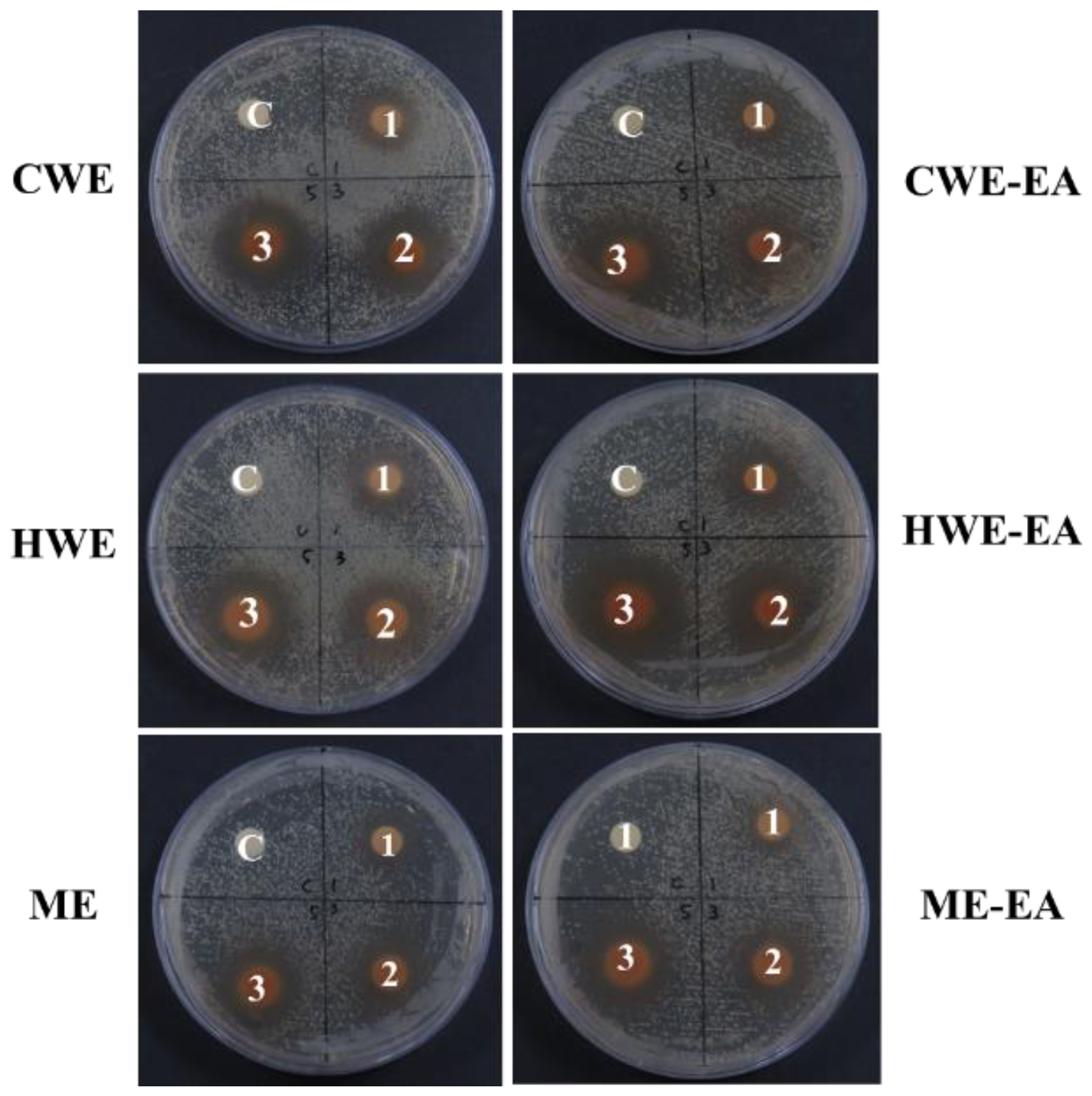
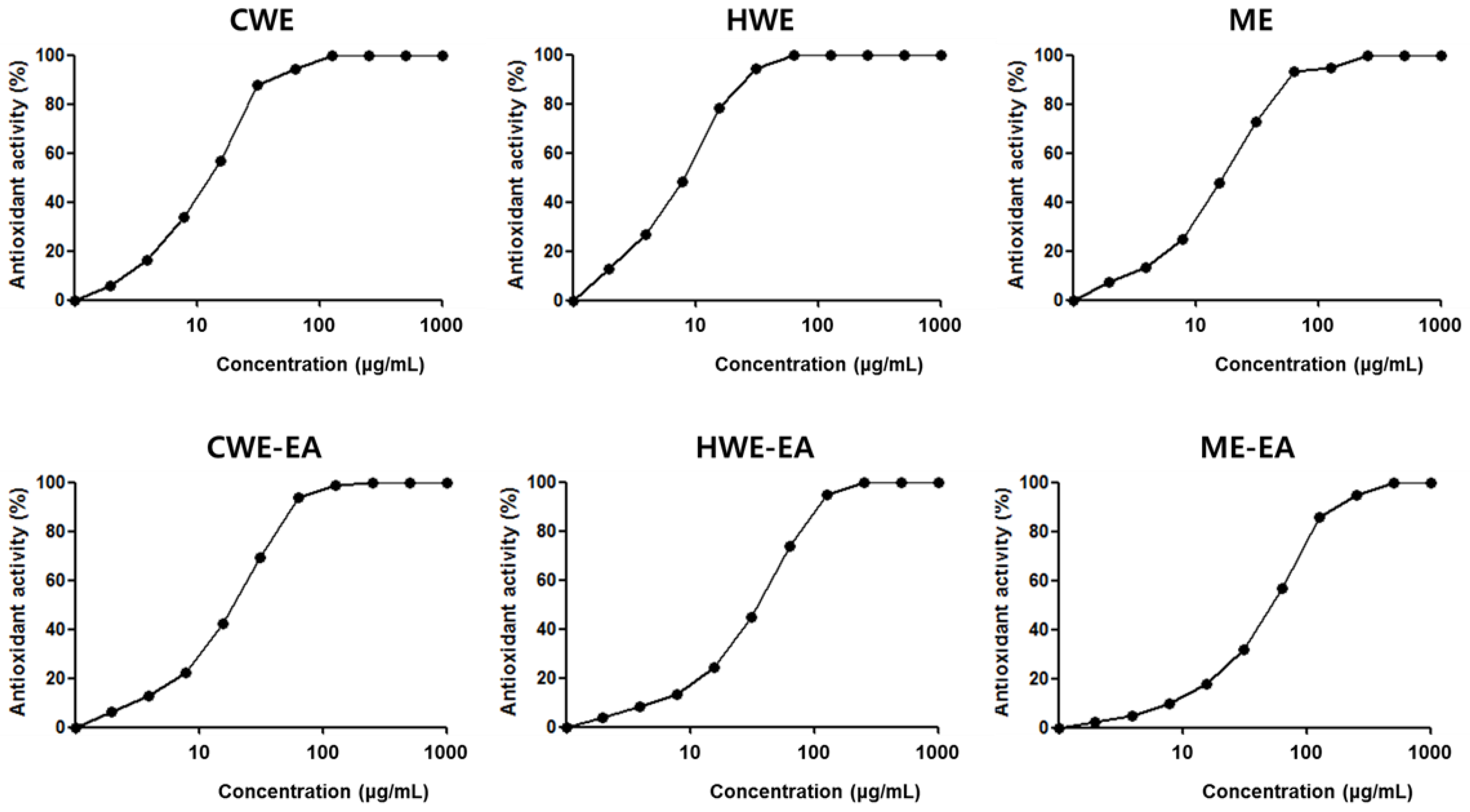

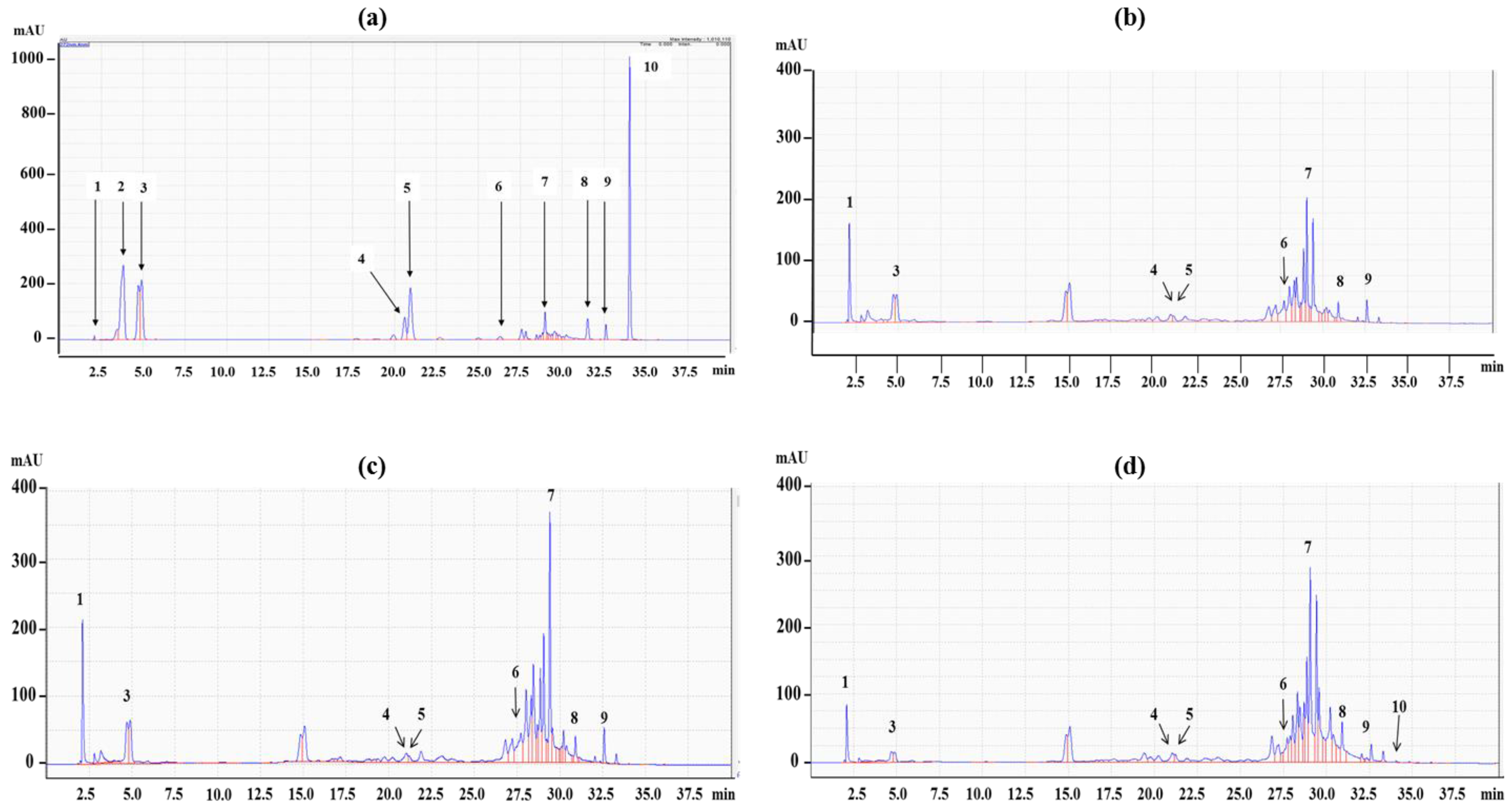
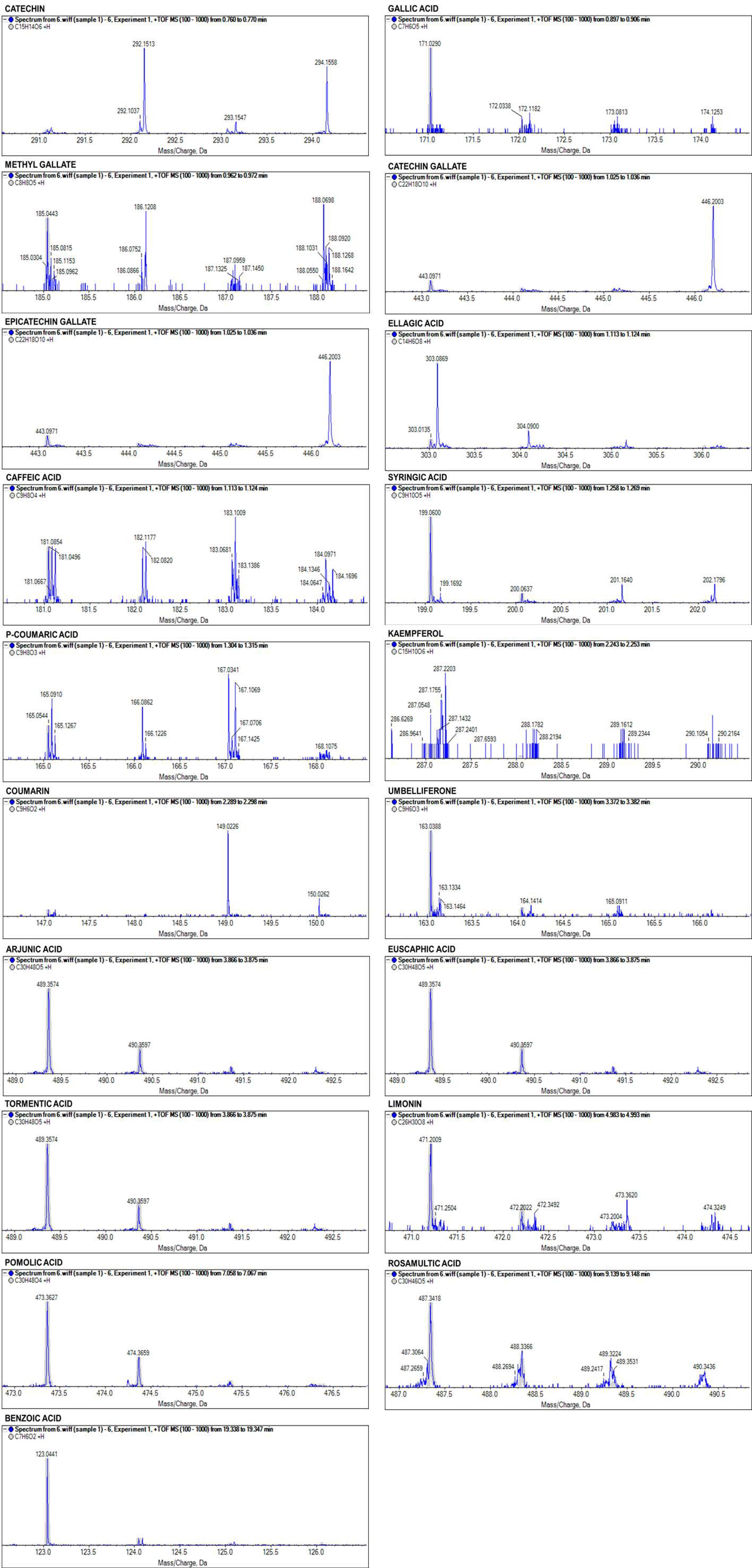
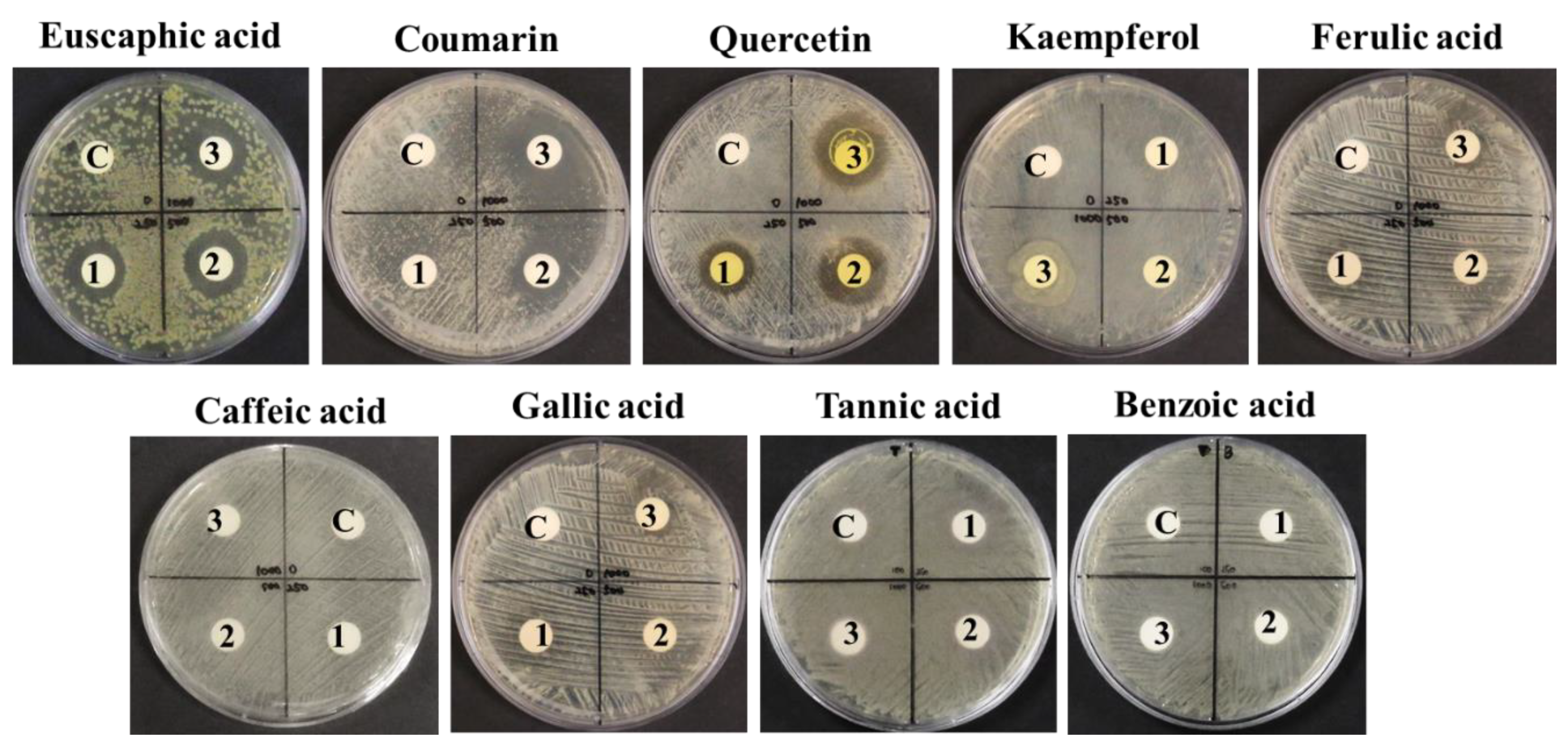
| Extract/Fraction | Total Phenolic Content (mg GAE/g ± SD) | Total Flavonoid Content (mg QE/g ± SD) | Total Terpenoid Content (mg/g ± SD) | Condensed Tannin Content (mg CE/g ± SD) |
|---|---|---|---|---|
| CWE | 59.0 ± 0.57 d | 20.6 ± 0.39 ab | 29.10 ± 0.000 c | 1.69 ± 0.058 b |
| HWE | 60.0 ± 1.15 d | 30.2 ± 2.46 c | 27.40 ± 0.001 b | 1.80 ± 0.004 c |
| ME | 46.1 ± 3.23 c | 17.9 ± 0.81 a | 22.38 ± 0.001 a | 1.14 ± 0.001 a |
| CWE-EA | 58.1 ± 1.89 d | 20.9 ± 0.34 ab | 29.69 ± 0.001 c | 2.15 ± 0.002 e |
| HWE-EA | 38.3 ± 2.41 b | 20.1 ± 0.92 ab | 26.29 ± 0.001 b | 2.06 ± 0.001 ab |
| ME-EA | 25.6 ± 1.99 a | 18.2 ± 2.31 ab | 29.68 ± 0.001 c | 1.73 ± 0.007 ab |
| Extract & Fraction | MIC (μg/mL) | MBC (μg/mL) |
|---|---|---|
| CWE | 1250 | 2500 |
| HWE | 625 | 1250 |
| ME | 312 | 312 |
| CWE-EA | 312 | 312 |
| HWE-EA | 156 | 312 |
| ME-EA | 78 | 156 |
| Sample | Compound Name | Score (%) | Formula | Intensity | Expected/Found (m/z) | Error (ppm) | RT (min) |
|---|---|---|---|---|---|---|---|
| CWE-EA | Gallic acid | 93 | C7H6O5 | 10,437 | 171.0288/171.0287 | −0.7 | 0.91 |
| Myricetin | 93 | C15H10O8 | 2638 | 319.0448/319.0447 | −0.5 | 1.06 | |
| Caffeic acid | 94 | C9H8O4 | 5899 | 181.0495/181.0494 | −0.7 | 1.15 | |
| Trans-ferulic acid | 92 | C10H10O4 | 3584 | 195.0652/195.0652 | −0.1 | 1.33 | |
| Umbelliferone | 93 | C9H6O3 | 8637 | 163.0390/163.0388 | −0.9 | 3.38 | |
| Arjunic acid | 92 | C30H48O5 | 18,571 | 489.3575/489.3571 | −0.7 | 3.88 | |
| Euscaphic acid | 92 | C30H48O5 | 18,571 | 489.3575/489.3571 | −0.7 | 3.88 | |
| Tormentic acid | 92 | C30H48O5 | 18,571 | 489.3575/489.3571 | −0.7 | 3.88 | |
| Pomolic acid | 94 | C30H48O4 | 56,259 | 473.3625/473.3623 | −0.6 | 3.88 | |
| Rosamultic acid | 54 | C30H46O5 | 14,695 | 487.3418/487.3415 | −0.7 | 8.24 | |
| Oleic acid | 94 | C18H34O2 | 55,293 | 283.2632/283.2630 | −0.7 | 12.27 | |
| Benzoic acid | 96 | C7H6O2 | 33,141 | 123.0441/123.0440 | −0.4 | 19.92 | |
| HWE-EA | Catechin | 51 | C15H14O6 | 3749 | 291.0863/291.0864 | 0.4 | 0.73 |
| Gallic acid | 61 | C7H6O5 | 8040 | 171.0288/171.0288 | −0.1 | 0.92 | |
| Hyperoside | 66 | C21H20O12 | 2389 | 465.1028/465.1032 | 1.0 | 1.00 | |
| Catechin gallate | 79 | C22H18O10 | 2560 | 443.0973/443.0975 | 0.6 | 1.06 | |
| epicatechin gallate | 79 | C22H18O10 | 2560 | 443.0973/443.0975 | 0.6 | 1.06 | |
| Ellagic acid | 77 | C14H6O8 | 9047 | 303.0135/303.0136 | −0.2 | 1.07 | |
| Caffeic acid | 92 | C9H8O4 | 4961 | 181.0495/181.0496 | 0.6 | 1.15 | |
| Syringic acid | 88 | C9H10O5 | 16,304 | 199.0601/199.0599 | −0.9 | 1.25 | |
| Trans-ferulic acid | 74 | C10H10O4 | 4102 | 195.0652/195.0650 | −0.7 | 1.30 | |
| Umbelliferone | 92 | C9H6O3 | 9133 | 163.0390/163.0388 | −1.0 | 1.93 | |
| Quercetin | 87 | C15H10O7 | 2978 | 303.0499/303.0498 | −0.4 | 2.35 | |
| Arjunic acid | 64 | C30H48O5 | 14,370 | 489.3575/489.3577 | 0.5 | 3.89 | |
| Euscaphic acid | 64 | C30H48O5 | 14,370 | 489.3575/489.3577 | 0.5 | 3.89 | |
| Tormentic acid | 64 | C30H48O5 | 14,370 | 489.3575/489.3577 | 0.5 | 3.89 | |
| Kaempferol | 85 | C15H10O6 | 1929 | 287.0550/287.0551 | 0.4 | 3.90 | |
| Limonin | 77 | C26H30O8 | 14,017 | 471.2013/471.2001 | −2.7 | 4.99 | |
| Pomolic acid | 94 | C30H48O4 | 29,780 | 473.3625/473.3622 | −0.7 | 7.06 | |
| Rosamultic acid | 57 | C30H46O5 | 9707 | 487.3418/487.3420 | 0.3 | 8.25 | |
| Benzoic acid | 93 | C7H6O2 | 40,741 | 123.0441/123.0439 | −1.0 | 20.30 | |
| ME-EA | Catechin | 50 | C15H14O6 | 5571 | 291.0863/291.0865 | 0.8 | 0.73 |
| Gallic acid | 55 | C7H6O5 | 9194 | 171.0288/171.0290 | 1.0 | 0.88 | |
| Methyl gallate | 86 | C8H8O5 | 3047 | 185.0444/185.0443 | −1.0 | 0.95 | |
| Catechin gallate | 74 | C22H18O10 | 4935 | 443.0973/443.0971 | −0.5 | 1.04 | |
| Epicatechin gallate | 74 | C22H18O10 | 4935 | 443.0973/443.0971 | −0.5 | 1.04 | |
| Ellagic acid | 96 | C14H6O8 | 4378 | 303.0135/303.0135 | −0.1 | 1.07 | |
| Caffeic acid | 96 | C9H8O4 | 2066 | 181.0495/181.0496 | 0.4 | 1.07 | |
| Syringic acid | 95 | C9H10O5 | 31,460 | 199.0601/199.0600 | −0.7 | 1.26 | |
| p-coumaric acid | 60 | C9H8O3 | 1944 | 165.0546/165.0544 | −1.6 | 1.36 | |
| Kaempferol | 81 | C15H10O6 | 2560 | 287.0550/287.0548 | −0.7 | 2.25 | |
| Coumarin | 84 | C9H6O2 | 4101 | 147.0441/147.0442 | 1.1 | 2.27 | |
| Umbelliferone | 93 | C9H6O3 | 9469 | 163.0390/163.0388 | −0.9 | 3.36 | |
| Arjunic acid | 74 | C30H48O5 | 26,745 | 489.3575/489.3574 | −0.1 | 3.85 | |
| Euscaphic acid | 74 | C30H48O5 | 26,745 | 489.3575/489.3574 | −0.1 | 3.85 | |
| Tormentic acid | 74 | C30H48O5 | 26,745 | 489.3575/489.3574 | −0.1 | 3.85 | |
| Limonin | 56 | C26H30O8 | 11,658 | 471.2013/471.2099 | −1.0 | 4.99 | |
| Pomolic acid | 97 | C30H48O4 | 92,518 | 473.3625/473.3627 | 0.4 | 7.06 | |
| Rosamultic acid | 55 | C30H46O5 | 55,933 | 487.3418/487.3418 | 0.1 | 9.29 | |
| Benzoic acid | 97 | C7H6O2 | 37,983 | 123.0441/123.0441 | 0.4 | 19.32 |
© 2018 by the authors. Licensee MDPI, Basel, Switzerland. This article is an open access article distributed under the terms and conditions of the Creative Commons Attribution (CC BY) license (http://creativecommons.org/licenses/by/4.0/).
Share and Cite
Kim, S.; Oh, S.; Noh, H.B.; Ji, S.; Lee, S.H.; Koo, J.M.; Choi, C.W.; Jhun, H.P. In Vitro Antioxidant and Anti-Propionibacterium acnes Activities of Cold Water, Hot Water, and Methanol Extracts, and Their Respective Ethyl Acetate Fractions, from Sanguisorba officinalis L. Roots. Molecules 2018, 23, 3001. https://doi.org/10.3390/molecules23113001
Kim S, Oh S, Noh HB, Ji S, Lee SH, Koo JM, Choi CW, Jhun HP. In Vitro Antioxidant and Anti-Propionibacterium acnes Activities of Cold Water, Hot Water, and Methanol Extracts, and Their Respective Ethyl Acetate Fractions, from Sanguisorba officinalis L. Roots. Molecules. 2018; 23(11):3001. https://doi.org/10.3390/molecules23113001
Chicago/Turabian StyleKim, Seongdae, Sung Oh, Han Byul Noh, Seongmi Ji, Song Hee Lee, Jung Mo Koo, Chang Won Choi, and Hyun Pyo Jhun. 2018. "In Vitro Antioxidant and Anti-Propionibacterium acnes Activities of Cold Water, Hot Water, and Methanol Extracts, and Their Respective Ethyl Acetate Fractions, from Sanguisorba officinalis L. Roots" Molecules 23, no. 11: 3001. https://doi.org/10.3390/molecules23113001
APA StyleKim, S., Oh, S., Noh, H. B., Ji, S., Lee, S. H., Koo, J. M., Choi, C. W., & Jhun, H. P. (2018). In Vitro Antioxidant and Anti-Propionibacterium acnes Activities of Cold Water, Hot Water, and Methanol Extracts, and Their Respective Ethyl Acetate Fractions, from Sanguisorba officinalis L. Roots. Molecules, 23(11), 3001. https://doi.org/10.3390/molecules23113001






